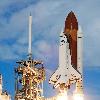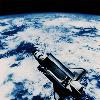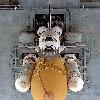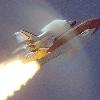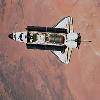

Tags: Space Shuttle View |
Higher resolution Tags: Space Shuttle View |
Tags: Space Shuttle View |
|||||||||
Tags: Space Shuttle View |
Tags: Space Shuttle View |
Tags: Space Shuttle View |
|||||||||
The Space Shuttle, part of the Space Transportation System (STS), is an American spacecraft operated by NASA for orbital human spaceflight missions. The first of four test flights occurred in 1981, which were followed by operational flights beginning in 1982. The system is scheduled to be retired from service in 2010 after 134 launches. Major missions have included launching numerous satellites and interplanetary probes, conducting space science experiments, and servicing and construction of space stations. The Shuttle has been used for orbital space missions by NASA, the U.S. Department of Defense, the European Space Agency, and Germany. The United States funded STS development and shuttle operations.
At launch, the Space Shuttle consists of a dark orange-colored external tank (Space Shuttle external tank) (ET);"NASA Takes Delivery of 100th Space Shuttle External Tank". NASA, August 16, 1999. Quote: "?orange spray-on foam used to insulate?""Media Invited To See Shuttle External Fuel Tank Ship From Michoud". NASA, December 28, 2004. Quote: "The gigantic, rust-colored external tank?" two white, slender Solid Rocket Boosters (Space Shuttle Solid Rocket Booster) (SRBs); and the STS Orbiter Vehicle (Space Shuttle orbiter) (OV) which contains the crew and payload. Payloads can be launched into higher orbits with either of two different booster stages developed for STS (1 stage PAM or 2 stage IUS).
The shuttle stack launches vertically like a conventional rocket from a mobile launch platform. It lifts off under the power of its two solid rocket boosters (SRBs) and its three main engines (SSMEs), the latter fueled by liquid hydrogen and liquid oxygen from the external tank. The Space Shuttle has a two stage ascent. The boosters are used only for the first stage, while the main engines burn for both stages. About two minutes after liftoff, staging occurs: the SRBs are released, and shortly begin falling by parachutes into the ocean to be retrieved by ship for reuse. The shuttle orbiter and external tank continue to ascend under power from the three main engines and their inertia. Upon reaching orbit, the main engines are shut down, and the external tank is jettisoned downward and falls to burn up in the atmosphere. However, it is possible for it to be re-used in orbit for various applications. At this point, the orbital maneuvering system (OMS) engines may be used to adjust or circularize the achieved orbit.
The orbiter carries astronauts and payload such as satellites or space station parts into low earth orbit, into the Earths upper atmosphere or thermosphere. Usually, five to seven crew members ride in the orbiter. Two crew members, the Commander and Pilot, are sufficient for a minimal flight, as in the first four "test" flights, STS-1 through STS-4. A typical payload capacity is about convert22700kglbsigfig=3sp=us, but can be raised depending on the choice of launch configuration. The orbiter carries the payload in a large cargo bay with doors that open along the length of its top, a feature which makes the Space Shuttle unique among present spacecraft. This feature made possible the deployment of large satellites such as the Hubble Space Telescope, and also to capture and return large payloads back to Earth.
When the orbiters space mission is complete it fires its Orbital Maneuvering System (OMS) thrusters to drop out of orbit and re-enter (Atmospheric reentry) the lower atmosphere. During the descent, the shuttle orbiter passes through different layers of the atmosphere and decelerates from hypersonic speed primarily by aerobraking. In the lower atmosphere and landing phase, it acts as a glider (Glider aircraft) with reaction control system (RCS) thrusters and fly-by wire controlled hydraulically actuated flight surfaces controlling its descent. It then makes a landing on a long runway as a spaceplane. The aerodynamic shape is a compromise between the demands of radically different speeds and air pressures during re-entry, subsonic atmospheric flight, and hypersonic flight. As a result the orbiter has a high sink rate at low altitudes, and transitions from using RCS thrusters in low pressure to flight surfaces at low altitudes.
With more than 2.5 million parts, the Space Shuttle has been called the most complex machine yet created by humanity.
Function: Manned partially reusable launch and reentry system
Manufacturer: United Space Alliance:,Thiokol/Alliant Techsystems (SRBs),Lockheed Martin (Martin Marietta) - (ET),Rockwell (Rockwell International)/Boeing (orbiter)
Height: 1.84 Mtr
Alt-height: 56.1 m
Diameter: 28.5 ft
Alt-diameter: 8.69 m
Mass: 4,470,000 lbm
Alt-mass: 2,030 t
Stages: 2
Leo-payload: 24,400 kg
Alt-leo: 53,600 lb
Payload-location: GTO (Geostationary transfer orbit)
Payload: 3,810 kg
Alt-payload: 8,390 lbm
Sites: LC-39 (Kennedy Space Center Launch Complex 39), Kennedy Space Center,SLC-6 (Vandenberg AFB Space Launch Complex 6), Vandenberg AFB (Vandenberg Air Force Base) (unused)
Launches: 131
Success: 130
Fail: 1 (launch failure (Space Shuttle Challenger disaster), ''Challenger (Space Shuttle Challenger)'')
Other Outcome: 1 (re-entry failure (Space Shuttle Columbia disaster), ''Columbia (Space Shuttle Columbia)'')
Payloads: Tracking and Data Relay Satellites ,Spacelab ,Great Observatories (Including Hubble) (Great Observatories program) ,Galileo (Galileo spacecraft) ,Magellan (Magellan probe) ,Space Station components (International Space Station)
First: April 12, 1981
Plannedretirement: 2010
Boosters: 2
Boostername: Solid Rocket Boosters (Space Shuttle Solid Rocket Booster)
Boosterengines: 1 solid (Solid-fuel rocket)
Boosterthrust: 2,800,000 lbf (pound force) each, sea level liftoff
Alt-boosterthrust: 12.5 MN (meganewton)
Boostersi: 269 s
Boostertime: 124 s
Boosterfuel: solid
Stage1name: External Tank (Shuttle External Tank)
Stage1engines: (none) ,(3 SSME (Space Shuttle main engine)s located on Orbiter)
Stage1thrust: 1,225,704 lbf total, sea level liftoff
Alt-stage1thrust: 5.45220 MN
Stage1si: 455 s
Stage1time: 480 s
Stage1fuel: LOX (Liquid oxygen)/LH2 (Liquid hydrogen)
Stage2name: Orbiter (Space Shuttle Orbiter)
Stage2engines: 2 OME (Orbital Maneuvering System)
Stage2thrust: 53.4 kN combined total vacuum thrust
Alt-stage2thrust: 12,000 lbf
Stage2si: 316 s
Stage2time: 1250 s
Stage2fuel: MMH (Monomethylhydrazine)/N2O4 (Dinitrogen tetroxide)


